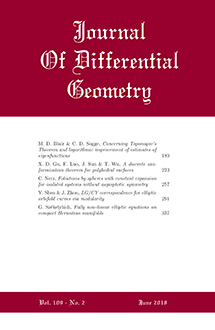Mark Gross, P. M. H. Wilson
J. Differential Geom. 55 (3), 475-546, (July, 2000) DOI: 10.4310/jdg/1090341262

Motivated by the picture of mirror symmetry suggested by Strominger, Yau and Zaslow, we make a conjecture concerning the Gromov-Hausdorff limits of Calabi-Yau n-folds (with Ricci-flat Kähler metric) as one approaches a large complex structure limit point in moduli; a similar conjecture was made independently by Kontsevich, Soibelman and Todorov. Roughly stated, the conjecture says that, if the metrics are normalized to have constant diameter, then this limit is the base of the conjectural special lagrangian torus fibrations associated with the large complex structure limit, namely an n-sphere, and that the metric on this Sn is induced from a standard (singular) Riemannian metric on the base, the singularities of the metric corresponding to the limit discriminant locus of the fibrations. This conjecture is trivially true for elliptic curves; in this paper we prove it in the case of K3 surfaces. Using the standard description of mirror symmetry for K3 surfaces and the hyperkähler rotation trick, we reduce the problem to that of studying Kähler degenerations of elliptic K3 surfaces, with the Kähler class approaching the wall of the Kähler cone corresponding to the fibration and the volume normalized to be one. Here we are able to write down a remarkably accurate approximation to the Ricci-flat metric: if the elliptic fibres are of area ∊ > 0, then the error is O(e−C/∊) for some constant C > 0. This metric is obtained by gluing together a semi-flat metric on the smooth part of the fibration with suitable Ooguri-Vafa metrics near the singular fibres. For small ∊, this is a sufficiently good approximation that the above conjecture is then an easy consequence.

